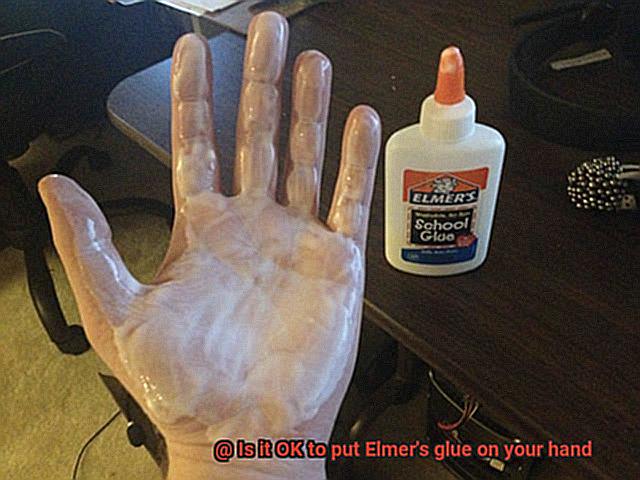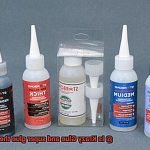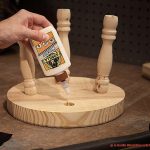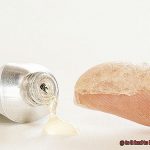Elmer’s glue – the ultimate arts and crafts sidekick. But did you know it’s also making waves as a peel-off hand treatment? Yup, people are slathering this sticky stuff on their hands for some kind of magical beauty boost. It’s weirdly fascinating, right? But before you go dipping your fingers in glue, let’s take a closer look at whether it’s actually safe.
In this blog post, we’ll dive into the nitty-gritty of using Elmer’s glue on your hands. We’ll explore the potential benefits and risks so you can make an informed decision about getting your hands dirty – or rather, sticky. So let’s roll up our sleeves (literally) and uncover the truth behind this quirky trend.
Safety Considerations of Using Elmer’s Glue on the Skin
Contents
- 1 Safety Considerations of Using Elmer’s Glue on the Skin
- 2 Potential Side Effects of Prolonged Exposure to Elmer’s Glue
- 3 How to Properly Use Elmer’s Glue on the Skin
- 3.1 Clean and Dry Skin:
- 3.2 Patch Test:
- 3.3 Thin and Even Application:
- 3.4 Be mindful not to apply too much pressure while spreading the glue, as this can cause streaks or uneven coverage. Take your time and work slowly to ensure an even application. If you notice any excess glue pooling in certain areas, gently dab it away with a clean cloth or tissue.
- 3.5 Time to Remove:
- 4 What Should be Done in Case of Irritation or Allergic Reaction?
- 5 Why You Should Not Ingest or Use Elmer’s Glue Near Eyes and Mouths
- 6 Tips for Exercising Caution When Using Elmer’s Glue on the Skin
- 7 When to Consult a Healthcare Professional about Using Elmer’s Glue
- 8 Conclusion
Elmer’s glue is a popular adhesive commonly used in arts and crafts projects, particularly by children. While it is generally deemed safe, there are crucial safety considerations to bear in mind when applying it directly on the skin. In this article, we will examine the potential risks, precautions, and benefits associated with using Elmer’s glue on the skin.
Risks and Precautions:
- Skin Irritation: Prolonged and excessive exposure to Elmer’s glue can cause skin irritation in some individuals. It is vital to note that Elmer’s glue is not designed or intended for use on the skin. To minimize the risk of skin irritation, avoid applying it directly on open wounds or broken skin.
- Allergic Reactions: Some people may be allergic to the ingredients in Elmer’s glue, such as polyvinyl acetate. If you experience redness, itching, or swelling after applying Elmer’s glue on your skin, discontinue use and consult a healthcare professional.
- Difficulty in Removal: The adhesive properties of Elmer’s glue can cause it to stick tightly to the skin, making it challenging to remove without causing discomfort or potential injury. It is important to be gentle when removing the glue from the skin to avoid any damage.
Benefits:
- Temporary Body Art: Using Elmer’s glue on the skin can be a fun and creative way to create temporary body art. With a little imagination and some glitter or colored pencils, you can create unique designs that wash off easily with soap and water.
- Wound Closure: In some cases, Elmer’s glue has been used as an alternative method for closing minor cuts or wounds. However, this should only be done under the guidance of a healthcare professional who can assess the situation and provide appropriate medical advice.
While Elmer’s glue is generally safe for use on the skin, it is important to exercise caution and follow the instructions provided by the manufacturer. Prolonged exposure or allergic reactions can lead to skin irritation, so it is advisable to avoid applying it directly on open wounds or broken skin. If any adverse reactions occur, discontinue use and consult a healthcare professional. Remember to prioritize your safety when using any product on your skin.
Additional Safety Considerations:
- Sensitivity Testing: Before applying Elmer’s glue on a large area of the skin, consider performing a patch test on a small, inconspicuous area to check for any adverse reactions or allergies.
- Avoiding Sensitive Areas: Take care to avoid applying Elmer’s glue near sensitive areas such as the eyes, mouth, or mucous membranes. In case of accidental contact, rinse the area thoroughly with water.
- Ingestion Risks: Keep in mind that Elmer’s glue should never be ingested. Swallowing large amounts of glue can lead to gastrointestinal issues. If accidental ingestion occurs, seek immediate medical attention.
- Age Considerations: While Elmer’s glue is commonly used by children, it is important to supervise their use and ensure they follow proper safety guidelines. Young children should only use Elmer’s glue under adult supervision.
Potential Side Effects of Prolonged Exposure to Elmer’s Glue
While this popular adhesive is a staple in arts and crafts, it’s essential to be aware of the potential side effects that can arise from prolonged exposure. In this article, we’ll delve into the nitty-gritty details and discuss how to keep your skin safe while enjoying the wonders of Elmer’s glue.
Skin Irritation and Allergic Reactions:
Prolonged exposure to Elmer’s glue can lead to skin irritation and allergic reactions. The glue contains chemicals such as ethylene-vinyl acetate copolymer, which can cause redness, itching, and inflammation of the skin. Individuals with sensitive skin or existing allergies are more prone to developing contact dermatitis, which presents as itchy, red, and inflamed skin. In rare cases, severe allergic reactions such as hives or anaphylaxis may occur. Anaphylaxis is a life-threatening condition that requires immediate medical attention.
Chemical Burns:
Prolonged exposure to Elmer’s glue on a large area of the skin or for an extended period can lead to chemical burns. The chemicals in the glue can cause a burning sensation and damage the skin, resulting in blisters, peeling, and pain. Chemical burns not only cause discomfort but can also lead to potential scarring.
Gastrointestinal Problems:
Ingesting Elmer’s glue is not recommended as it can lead to gastrointestinal issues such as nausea, vomiting, abdominal pain, and diarrhea. Remember, Elmer’s glue is not intended for consumption.
Safety Measures:
To minimize the risk of side effects, follow these safety measures:
- Use Elmer’s glue as directed for non-skin-related purposes (sticking paper, crafts).
- Test a small patch of skin before applying the glue to a larger area to check for any adverse reactions.
- Discontinue use if any skin irritation, allergic reactions, or discomfort occur.
How to Properly Use Elmer’s Glue on the Skin
Elmer’s glue is a fantastic adhesive for your arts and crafts projects. Did you know that it can also be used on your skin? In this guide, we will show you how to properly use Elmer’s glue on your skin, ensuring both safety and fun.
Clean and Dry Skin:
Before you apply Elmer’s glue to your skin, it’s important to make sure your skin is squeaky clean and dry. This helps the glue stick better and prevents any dirt or oils from interfering with its effectiveness. So, wash the area with mild soap and water and pat it dry gently.

To begin, choose a suitable area of skin where you want to apply the glue. It’s important to avoid broken or irritated skin, as this may cause discomfort or irritation when the glue is applied. Once you have chosen the area, cleanse it thoroughly with mild soap and warm water. Gently rub the area in circular motions to remove any dirt or oils that may be present. Rinse the area well and pat it dry with a clean towel.
Patch Test:
To be extra safe, do a patch test on a small area of your skin before applying Elmer’s glue to a larger area. Apply a tiny amount of glue and wait for a few minutes. If there’s no redness or irritation, then you’re good to go.
Before applying Elmer’s glue to a larger area of your skin, it’s essential to perform a patch test. This involves applying a small amount of glue to a small, inconspicuous area of your skin and waiting for at least 10-15 minutes to see if any adverse reactions occur. This step is crucial because everyone’s skin reacts differently to different substances, and it’s better to be safe than sorry.
To perform a patch test, take a small amount of Elmer’s glue and apply it to the inside of your forearm or behind your ear. Gently spread the glue in a thin layer and wait for 10-15 minutes. During this time, avoid touching or scratching the area. If you experience any redness, itching, swelling, or irritation during this period, remove the glue immediately and wash the area with warm water. If there are no adverse reactions, you can proceed with using Elmer’s glue on a larger area of your skin.
Thin and Even Application:
When applying Elmer’s glue to your skin, remember that a little goes a long way. Use a thin layer and spread it evenly over the desired area. Avoid applying too much glue as it may take longer to dry and become uncomfortable when removing later.
For an even application of Elmer’s glue on your skin, take a small amount of glue on your fingertip or a clean brush. Start by applying a thin layer to the center of the desired area and gently spread it outwards in smooth, even strokes. Make sure to cover the entire desired area with a thin and even layer of glue.
Be mindful not to apply too much pressure while spreading the glue, as this can cause streaks or uneven coverage. Take your time and work slowly to ensure an even application. If you notice any excess glue pooling in certain areas, gently dab it away with a clean cloth or tissue.
Time to Remove:
Elmer’s glue is not meant to stay on your skin for too long. After a few hours, it’s time to bid farewell. Gently peel off any dried glue. If it doesn’t come off easily, soak the area in warm water to loosen it. Avoid pulling forcefully or scrubbing, as this can irritate your skin.
What Should be Done in Case of Irritation or Allergic Reaction?

We all love getting creative and having fun with Elmer’s glue, but sometimes things don’t go as planned. If you’ve experienced irritation or an allergic reaction after putting glue on your hand, don’t worry. I’m here to guide you through the steps you should take to alleviate discomfort and ensure your artistic adventures remain enjoyable.
Step 1: Gently remove the glue:
First and foremost, gently remove the glue from the affected area. Avoid rubbing or scratching, as this can worsen the irritation. Instead, try peeling off the glue or use a mild soap and water to wash it off. Remember, be gentle with your skin.
Step 2: Rinse with cool water:

After removing the glue, rinse the area with cool water. This helps soothe the skin and remove any remaining residue. Avoid using hot water, as it can potentially make the irritation worse.
Step 3: Apply a cold compress:
If you notice redness, swelling, or itching, applying a cold compress can work wonders. Wrap some ice cubes in a clean cloth and gently press it against the affected area for a few minutes at a time. Ahh, relief.
Step 4: Seek relief with over-the-counter products:
To further soothe your irritated skin, reach for over-the-counter hydrocortisone cream or calamine lotion. These products can help relieve itching and reduce inflammation caused by allergic reactions.
Step 5: Consider antihistamines if necessary:
If you’re experiencing intense itching or hives due to an allergic reaction, it might be time to consider taking an over-the-counter antihistamine medication. However, it’s always wise to consult with a healthcare professional before popping any pills.
Step 6: Resist the itch:
I know it’s tempting, but scratching that itchy spot will only make things worse. Try your best to avoid scratching, as it can lead to further irritation or even infection. Keep your nails short and consider wearing gloves to prevent scratching during sleep.
Step 7: Seek medical attention if needed:
If your symptoms persist or worsen despite following these steps, it’s best to seek medical attention. A healthcare professional can evaluate the severity of the reaction and provide appropriate treatment or advice.
Remember, everyone reacts differently to Elmer’s glue, and some may be more prone to allergic reactions than others. If you have a known allergy to adhesive substances or have had previous allergic reactions, it’s best to avoid putting glue on your hand altogether. But don’t let that stop you from enjoying the wonders of glue in other creative ways.
Why You Should Not Ingest or Use Elmer’s Glue Near Eyes and Mouths
But when it comes to using Elmer’s glue, there’s one thing you should always keep in mind – never get it near your eyes and mouth. Why, you ask? Well, let’s dive into the sticky details.
First off, Elmer’s glue is not meant to be consumed. It contains chemicals that can be toxic if ingested. Trust me, stomach discomfort, nausea, and vomiting are not the kind of side effects you want after a fun afternoon of crafting. In more serious cases, it can even cause damage to your digestive system. Yikes.
But that’s not all, folks. The chemicals in Elmer’s glue are also not friendly to our precious peepers and pouts. If any of that gooey goodness accidentally finds its way into your eyes, it can cause irritation, redness, and even damage to your cornea. Ouch. And if you thought putting it near your mouth was a safer bet, think again. Glue in the mouth can lead to irritation and pose a choking hazard. Definitely not something you want to experience.

So how can we prevent these sticky situations? Well, first and foremost, keep Elmer’s glue away from our curious little ones. Children may be tempted to taste or play with it, so it’s crucial to supervise them during any crafting session.
In case of accidental contact with Elmer’s glue near your eyes or mouth, act fast. Rinse the affected area with plenty of clean water immediately. If irritation persists or worsens, don’t hesitate to seek medical attention.
And here’s a handy tip for you – there are alternative products available specifically designed for use near sensitive areas like your eyes and mouth. These products are formulated to be safe and are a better choice when working on projects that require adhesive near these areas.
Tips for Exercising Caution When Using Elmer’s Glue on the Skin

Elmer’s glue is a versatile adhesive commonly used for arts and crafts projects. While it can be applied to the skin, it’s crucial to exercise caution to avoid potential risks or adverse reactions. In this article, we will explore tips for safely using Elmer’s glue on the skin.
Cleanse the Area:
Before applying Elmer’s glue to your skin, ensure that the area is clean and free from dirt or oils. This allows the glue to adhere better and reduces the chances of irritation or infection.
Patch Test:
Always conduct a patch test by applying a small amount of glue to a small area of skin before using it on a larger area. This helps determine if you have any allergic reactions or sensitivities to the glue. If you experience redness, itching, discomfort, or swelling, immediately remove the glue and wash the area with mild soap and water.
Avoid Broken or Irritated Skin:
Do not apply Elmer’s glue to broken or irritated skin as it can worsen the condition and delay the healing process. Wait until the skin has fully healed before using the glue.
Apply a Thin and Even Layer:
When applying Elmer’s glue, ensure that you apply a thin and even layer. Applying too much glue increases the chances of it peeling off or causing discomfort when removed.
Avoid Sensitive Areas:
It is advisable to avoid applying Elmer’s glue to sensitive areas such as around the eyes, mouth, or genitals. These areas are more prone to irritation and may be more sensitive to the adhesive properties of the glue.
Remove Gently:
When removing Elmer’s glue from the skin, do not forcefully peel it off. Instead, gently loosen the edges and slowly peel it away. If any residue remains, use warm water and mild soap to wash it off.
When to Consult a Healthcare Professional about Using Elmer’s Glue
Using Elmer’s glue is generally safe for common household crafts and projects. However, there are certain situations where it is advisable to consult a healthcare professional to ensure your safety and well-being.
Allergies and Sensitivities:
If you have a known allergy or sensitivity to any of the ingredients in Elmer’s glue, it is important to consult a healthcare professional before using it. They can assess your condition and provide guidance on safe alternatives or precautions to take.
Ingestion:
Accidentally ingesting Elmer’s glue can cause gastrointestinal irritation and other complications. If you or someone else ingests the glue, it is important to seek immediate medical attention. Call your local poison control center or go to the nearest emergency room for proper evaluation and treatment.
Eye or Skin Contact:
If Elmer’s glue comes into contact with your eyes, it can cause irritation and potential damage. Similarly, applying the glue to broken or damaged skin can slow down the healing process and increase the risk of infection. If either of these situations occurs, it is important to consult a healthcare professional for proper evaluation and treatment.
Unusual Symptoms:
If you experience any unusual symptoms after using Elmer’s glue on your skin, such as redness, itching, swelling, or pain, it is best to consult a healthcare professional. These symptoms could indicate an allergic reaction or an underlying skin condition that needs medical attention.
Persistent Symptoms:
If symptoms of irritation or discomfort persist even after you have stopped using Elmer’s glue, it is important to seek medical advice. A healthcare professional can evaluate your condition and provide appropriate treatment or recommendations.
General Concerns:
If you have any general concerns about using Elmer’s glue on a specific area of your body or if you are unsure about its safety in your particular situation, consulting a healthcare professional is always a good idea. They can provide personalized advice based on your medical history and specific needs.
Also Read: Is Elmer’s Glue Toxic?
Conclusion
Putting Elmer’s glue on your hand may seem like a harmless and fun experiment, but it’s important to consider the potential risks involved. While Elmer’s glue is non-toxic and generally safe for use in crafts, it is not designed to be applied directly onto the skin.
When you put Elmer’s glue on your hand, it can create a thick layer that dries and hardens. This might give you a temporary sense of satisfaction as you peel it off, but it can also cause irritation and damage to your skin.
The glue contains chemicals that could potentially cause allergic reactions or skin irritation, especially if you have sensitive skin. Additionally, the drying process can strip away natural oils from your skin, leading to dryness and discomfort.
Furthermore, when you apply glue directly onto your hand, there is a risk of trapping bacteria or dirt underneath the layer of glue. This could potentially lead to infections or other complications.
In conclusion, while putting Elmer’s glue on your hand may seem like a harmless experiment or a way to create temporary entertainment, it is not recommended due to the potential risks involved.






